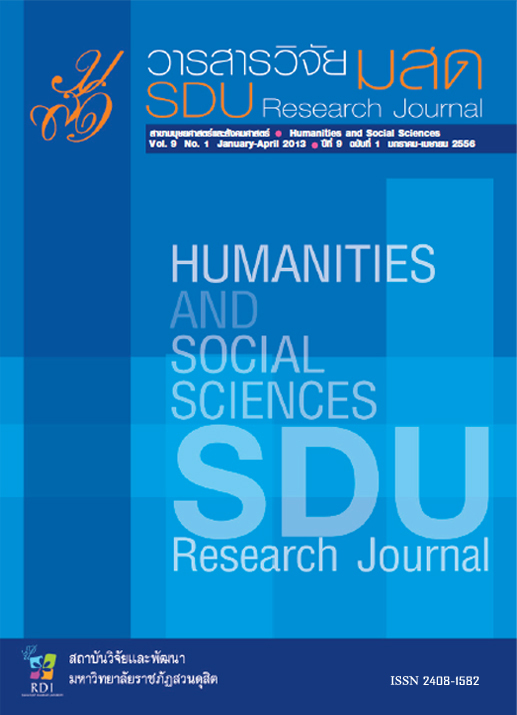การจัดกิจกรรมการเคลื่อนไหวร่วมกับการใช้ประสาทการรับรู้เพื่อส่งเสริมทักษะ กล้ามเนื้อมัดใหญ่ของเด็กพิการซ้อนอายุ 3-5 ปี
Keywords:
เด็กพิการซ้อน, กิจกรรมการเคลื่อนไหว, ประสาทการรับรู้Abstract
บทคัดย่อ
การศึกษาเรื่องการจัดกิจกรรมการเคลื่อนไหวร่วมกับการใช้ประสาทการรับรู้ เพื่อส่งเสริมทักษะกล้ามเนื้อมัดใหญ่ของเด็กพิการซ้อนอายุ 3-5 ปีมีวัตถุประสงค์เพื่อศึกษาหาความสามารถในการใช้กล้าเนื้อมักใหญ่ ของเด็กพิการซ้อน อายุ 3-5 ปี ก่อนและหลักการทำกิจกรรม โดยการใช้กิจกรรมการเคลื่อนไหวร่วมกับการใช้ประสาทการรับรู้ และเปรียบเทียบความสารมรในการใช้ทักษะกล้ามเนื้อมัดใหญ่ของเด็กพิการซ้อน อายุ 3-5 ปี ก่อนและหลังการทำกิจกรรม กลุ่มตัวอย่างที่ใช้ในการศึกษาครั้งนี้เป็นเด็กที่มีความพิการซ้อน คือบกพร่องทางการเห็นร่วมกับความบกพร่องทางสติปัญญา กำลังเรียนอยู่ในระดับเตรียมความพร้อม กลุ่มงานบริการช่วยเหลือระยะแรกเริ่มเด็กพิการและครอบครัว ศูนย์การศึกษาพิเศษ โรงเรียนสาธิตลอออุทิศ มหาวิทยาลัยราชภัฏสวนดุสิต ภาคเรียนที่ 2 ปีการศึกษา 2553 จำนวน 6 คน เลือกมาโดยวิธีสุ่มตัวอย่างแบบเจาะจงโดยทดลองเป็นรายบุคคล ระยะเวลาในการทดลอง 17 สัปดาห์ สัปดาห์ละ 2 วัน ๆ ละ 30 นาที เป็นการฝึกปฏิบัติรายบุคคล เครื่องมือที่ใช้ในการศึกษาครั้งนี้คือ แผนการจัดกิจกรรมเคลื่อนไหวร่วมกับการใช้ประสาทการรับรู้ จำนวน 30 แผน และแบบประเมินความสามารถในการใช้ทักษะกล้ามเนื้อมัดใหญ่ 15 ข้อ ซึ่งมีทักษะกล้ามเนื้อมัดใหญ่ 4 ด้าน คือ ด้านการนั่งและการยืน ด้านการเดินทรงตัว ด้านการวิ่งและการกระโดด ที่ผู้วิจัยสร้างขึ้น การวิเคราะห์ข้อมูล
Abstract
The objective of this research study was to compare the gross motor skills
of children aged between 3 to 5 years who had multiple disabilities before and after
implementing movement and sensory perception-enhanced activities. Participants were six
children with cognitive visual impairments selected by purposive sampling method. They
were studying at the pre-school level at the Early Intervention Group in the Special Education
Center at La-Or Utis Demonstration School in the second semester of the 2010 academic
year. The treatments in this study were 30 activity-plans which enhanced movements and
sensory perceptions. The participants received the treatments individually for 30 minutes a
day and two times a week for 17 weeks. The research instrument was a 15-item evaluation
form designed by the researcher. The purpose was to assess gross motor skills in four
aspects. They were 1) sitting-standing, 2) walking, 3) running, and 4) jumping. Collected data
were analyzed using descriptive statistics that were arithmetic mean, median and quartile
range; and the hypothesis was tested using the Wilcoxon matched-pairs signed-rank test.
The research findings were as follows:
1) The efficiency rate of the activity plans was 80.33/87 which was higher than the
standard at 80/80.
2) The gross motor skills of the participants after receiving the treatments were
rated Good.
3) The gross motor skills of the participants after receiving the treatments was
higher than those before receiving the treatments at significant level (p = .05).
Keywords: Multiple Disabilities, Movement Activities, Sensory Perception Enhanced Activities







